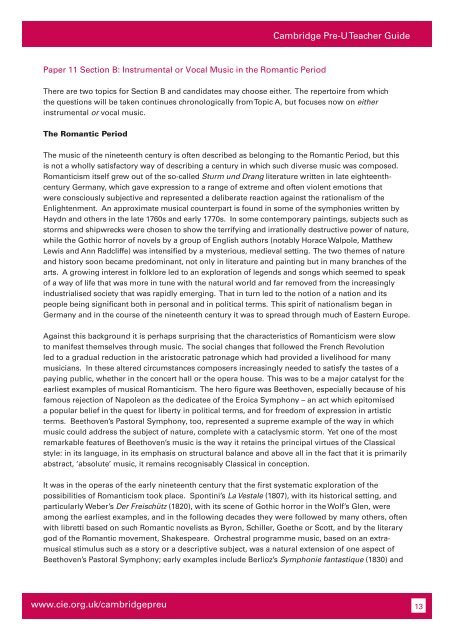Teacher's Guide Cambridge Pre-U MUSIC Available for teaching ...
Teacher's Guide Cambridge Pre-U MUSIC Available for teaching ...
Teacher's Guide Cambridge Pre-U MUSIC Available for teaching ...
Create successful ePaper yourself
Turn your PDF publications into a flip-book with our unique Google optimized e-Paper software.
Paper 11 Section B: Instrumental or Vocal Music in the Romantic Period<br />
<strong>Cambridge</strong> <strong>Pre</strong>-U Teacher <strong>Guide</strong><br />
There are two topics <strong>for</strong> Section B and candidates may choose either. The repertoire from which<br />
the questions will be taken continues chronologically from Topic A, but focuses now on either<br />
instrumental or vocal music.<br />
The Romantic Period<br />
The music of the nineteenth century is often described as belonging to the Romantic Period, but this<br />
is not a wholly satisfactory way of describing a century in which such diverse music was composed.<br />
Romanticism itself grew out of the so-called Sturm und Drang literature written in late eighteenthcentury<br />
Germany, which gave expression to a range of extreme and often violent emotions that<br />
were consciously subjective and represented a deliberate reaction against the rationalism of the<br />
Enlightenment. An approximate musical counterpart is found in some of the symphonies written by<br />
Haydn and others in the late 1760s and early 1770s. In some contemporary paintings, subjects such as<br />
storms and shipwrecks were chosen to show the terrifying and irrationally destructive power of nature,<br />
while the Gothic horror of novels by a group of English authors (notably Horace Walpole, Matthew<br />
Lewis and Ann Radcliffe) was intensified by a mysterious, medieval setting. The two themes of nature<br />
and history soon became predominant, not only in literature and painting but in many branches of the<br />
arts. A growing interest in folklore led to an exploration of legends and songs which seemed to speak<br />
of a way of life that was more in tune with the natural world and far removed from the increasingly<br />
industrialised society that was rapidly emerging. That in turn led to the notion of a nation and its<br />
people being significant both in personal and in political terms. This spirit of nationalism began in<br />
Germany and in the course of the nineteenth century it was to spread through much of Eastern Europe.<br />
Against this background it is perhaps surprising that the characteristics of Romanticism were slow<br />
to manifest themselves through music. The social changes that followed the French Revolution<br />
led to a gradual reduction in the aristocratic patronage which had provided a livelihood <strong>for</strong> many<br />
musicians. In these altered circumstances composers increasingly needed to satisfy the tastes of a<br />
paying public, whether in the concert hall or the opera house. This was to be a major catalyst <strong>for</strong> the<br />
earliest examples of musical Romanticism. The hero figure was Beethoven, especially because of his<br />
famous rejection of Napoleon as the dedicatee of the Eroica Symphony – an act which epitomised<br />
a popular belief in the quest <strong>for</strong> liberty in political terms, and <strong>for</strong> freedom of expression in artistic<br />
terms. Beethoven’s Pastoral Symphony, too, represented a supreme example of the way in which<br />
music could address the subject of nature, complete with a cataclysmic storm. Yet one of the most<br />
remarkable features of Beethoven’s music is the way it retains the principal virtues of the Classical<br />
style: in its language, in its emphasis on structural balance and above all in the fact that it is primarily<br />
abstract, ‘absolute’ music, it remains recognisably Classical in conception.<br />
It was in the operas of the early nineteenth century that the first systematic exploration of the<br />
possibilities of Romanticism took place. Spontini’s La Vestale (1807), with its historical setting, and<br />
particularly Weber’s Der Freischütz (1820), with its scene of Gothic horror in the Wolf’s Glen, were<br />
among the earliest examples, and in the following decades they were followed by many others, often<br />
with libretti based on such Romantic novelists as Byron, Schiller, Goethe or Scott, and by the literary<br />
god of the Romantic movement, Shakespeare. Orchestral programme music, based on an extramusical<br />
stimulus such as a story or a descriptive subject, was a natural extension of one aspect of<br />
Beethoven’s Pastoral Symphony; early examples include Berlioz’s Symphonie fantastique (1830) and<br />
www.cie.org.uk/cambridgepreu 13
















